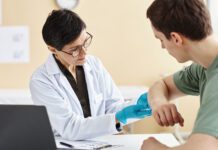According to the American Cancer Society, breast cancer remains one of the most common forms of cancer in American women, with 1 in 8 women expected to be diagnosed with invasive breast cancer in their lifetimes. Regular screening tests are the best way to detect cancer early, and guidelines for screenings have recently changed.
Wajeeha Razaq, M.D., who specializes in hematology and oncology at the OU Health Stephenson Cancer Center in Oklahoma City, says the United States Preventive Services Task Force revised its 2024 recommendations and now suggests starting routine biennial screenings at age 40, while both the American Cancer Society and European screening guidelines recommend starting screening at age 45.
“Many expert groups encourage shared decision-making for women in their 40s because of trade-offs between benefits and harms,” says Razaq.
For women ages 40 to 44, the American Cancer Society states that women “should have the choice to start yearly breast cancer screening with a mammogram if they wish to do so.” While the median age at the time of a breast cancer diagnosis is 62, half of women who develop breast cancer are 62 years or younger when diagnosed – with approximately nine percent of breast cancers occurring in women under age 45.
Razaq says in countries with established breast cancer screening programs, most breast cancers are found due to an abnormal mammogram.
“However, up to 15% of women are diagnosed with breast cancer due to the presence of a breast mass that is not detected on mammogram – known as mammographically occult disease – and another 30% present with a breast mass in the interval between mammograms,” says Razaq. “In addition, women without access to screening mammograms and younger women under 40 years who may not be undergoing routine screening mammograms may present with a breast or axillary mass with or without skin changes – and breast cancer can be painful or completely asymptomatic.”
She says hormone positive breast cancer is the most common type of breast cancer, while triple negative breast cancer makes up approximately 10-15% of cases and Her2 positive tumors make up an estimated 15% of cases.
Common breast cancer symptoms can include the discovery of a new lump or mass, swelling of all or part of a breast, skin dimpling, breast or nipple pain, nipple retraction and/or discharge, nipple or breast skin that is red, dry, flaking or thickened, and/or swollen lymph nodes under the arm or near the collarbone.
“For all women, I suggest that they should be very familiar with their breasts and any abnormality they see, they should report it to their primary care physician,” says Razaq, who recommends starting mammograms at age 40 and then following up with yearly exams.
“Women who have a personal history of breast, ovarian, peritoneal or fallopian tube cancer, certain genetic mutations (eg, BRCA1 or BRCA2, TP53), or a history of previous radiotherapy to the chest between ages 10 and 30 years, are at high risk for developing breast cancer. For patients with a lifetime risk of greater than 20 percent, I suggest a supplemental MRI in addition to mammography.”






















